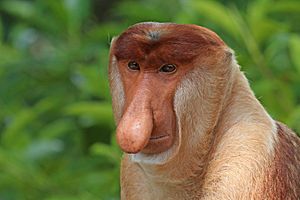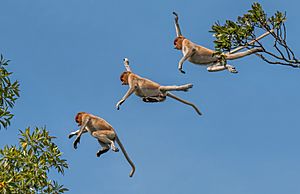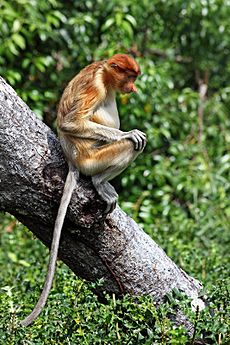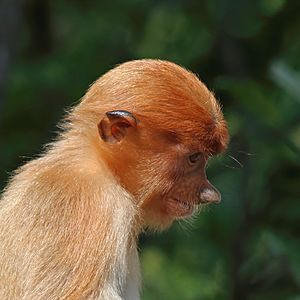Proboscis monkey facts for kids
Quick facts for kids Proboscis monkey |
|
|---|---|
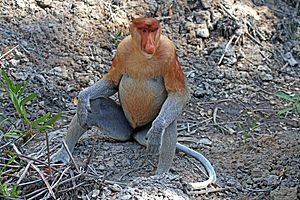 |
|
| Male, Labuk Bay, Sabah, Borneo, Malaysia | |
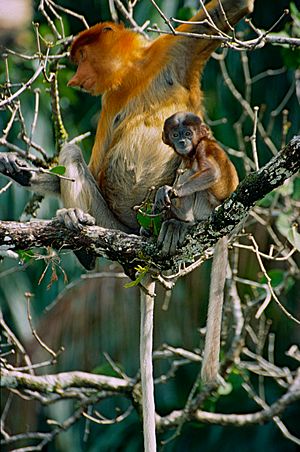 |
|
| Female with young, Sarawak, Borneo, Malaysia | |
| Conservation status | |
| Scientific classification | |
| Genus: |
Nasalis
|
| Species: |
larvatus
|
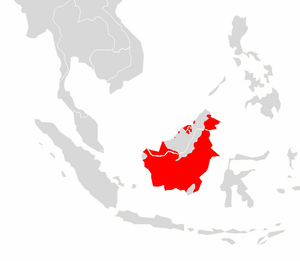 |
|
The proboscis monkey (Nasalis larvatus) is also called the long-nosed monkey. In Indonesia, it's known as the bekantan. This monkey has reddish-brown fur and a very large nose. It lives in trees and is an Old World monkey.
Proboscis monkeys are only found on the island of Borneo in southeast Asia. They share their home with Bornean orangutans. The proboscis monkey is the only species in its group, called Nasalis.
Contents
About Proboscis Monkeys
Proboscis monkeys are among the largest monkeys in Asia. Only the Tibetan macaque and some gray langurs are similar in size. Male and female proboscis monkeys look quite different. This is called Sexual dimorphism.
Males are bigger than females. Their bodies are about 66 to 76.2 cm (26.0 to 30.0 in) long. They usually weigh 16 to 22.5 kg (35 to 50 lb), but can weigh up to 30 kg (66 lb). Females are smaller, with bodies about 53.3 to 62 cm (21.0 to 24.4 in) long. They weigh 7 to 12 kg (15 to 26 lb), with a maximum of 15 kg (33 lb).
The most noticeable difference is the male's huge nose, which can be over 10.2 cm (4.0 in) long and hangs below its mouth. Scientists think females might prefer males with bigger noses because it helps them make louder calls. Even female proboscis monkeys have a fairly large nose compared to other primates.
Their fur is long and can be bright orange, reddish-brown, yellowish-brown, or brick-red on their backs. Their bellies are lighter, often light-grey or yellowish. Baby monkeys are born with blue faces, which turn grey around 2.5 months old. By 8.5 months, their faces become cream-colored, like the adults. Both male and female monkeys have large, bulging stomachs, making them look like they have a pot belly. Many of their toes are webbed, which helps them swim.
Proboscis Monkey Behavior
Social Life
Proboscis monkeys usually live in groups. These groups often have one adult male, several adult females, and their young. Sometimes, there are groups made up only of males. A few males might even live alone.
Monkey groups share the same areas, but they don't usually fight over territory. They live in a "fission-fusion society." This means groups can come together and split apart. For example, many groups might gather at sleeping spots when night falls. They might also join up to mate or groom each other. During the day, groups travel together, but monkeys only groom and play with others from their own small group.
A typical one-male group has about 3 to 12 monkeys, but can have more. Larger groups, called "bands," can have up to 60 monkeys. Serious fights are rare among these monkeys, though small disagreements can happen. Monkeys in the same band are generally friendly towards each other. Female monkeys have a pecking order, meaning some are more dominant than others.
Male monkeys can stay in their groups for six to eight years. When a new male takes over a group, it usually happens without big fights. Young males leave their birth groups when they become adults and join all-male groups. Females sometimes leave their birth groups too. This might be to find new mates, get more food, or improve their social standing.
Reproduction and Life Cycle
Female proboscis monkeys are pregnant for about 166 to 200 days. They usually give birth at night or in the early morning.
Young monkeys start eating solid food when they are about six weeks old. They stop drinking their mother's milk around seven months old. A young male's nose grows slowly until it reaches adulthood. Mother monkeys often let other members of their group hold their babies.
Communication
Proboscis monkeys use many different sounds to talk to each other. Males make "honks" to show where their group is. They have a special honk just for babies, which is also used to comfort them. Males also make alarm calls if there is danger nearby.
Both males and females make threat calls, but their sounds are different. Females and young monkeys make "female calls" when they are angry. During small arguments, they might honk, roar, or snarl. They also show their anger by shaking branches or opening their mouths to show their teeth.
Proboscis Monkey Ecology
Where They Live and Their Home
The proboscis monkey lives only on the island of Borneo. You can find them in Brunei, Indonesia, and Malaysia. They are most common near the coast and along rivers. These monkeys prefer low-lying areas that might be affected by tides. They especially like mangrove forests and forests along rivers. They can also live in swamp forests and other types of tropical forests. They usually stay within a kilometer of water.
Proboscis monkeys are very good swimmers, perhaps the best among primates. They can swim underwater for up to 20 m (66 ft). They are known to swim across rivers. Most of the time, they live in trees, moving on all fours or by leaping. They sometimes jump from branches directly into the water.
What They Eat and Daily Activities
Proboscis monkeys mainly eat fruit and leaves, depending on the season. They also eat some flowers, seeds, and insects. They eat at least 55 different types of plants. They prefer young leaves over older ones, and unripe fruits over ripe ones. From January to May, they eat mostly fruit. From June to December, they eat mostly leaves.
Groups usually sleep in trees close to each other, often near rivers. In the morning, they start by looking for food, then they rest further inland. Their day involves resting, traveling, eating, and watching for danger. Sometimes, they chew their cud, which helps them digest their food better. As evening comes, they move back towards the river to find more food.
Animals that hunt proboscis monkeys include crocodiles, clouded leopards, eagles, monitor lizards, and pythons. Monkeys will cross rivers at narrow spots or by moving through trees to avoid these predators.
Conservation Status
The proboscis monkey is listed as endangered on the IUCN Red List. This means their numbers have dropped by more than half in the last 36–40 years (up to 2008). This is mainly because their habitat is being destroyed by logging and palm oil farms. They are also hunted in some areas for food or for use in traditional medicine.
Their population is now broken into smaller groups. The largest groups are in Kalimantan (Indonesia). There are fewer monkeys in Sarawak, Brunei, and Sabah (Malaysia). The proboscis monkey is protected by law in all parts of Borneo.
Proboscis monkeys live in 16 protected areas. These include Danau Sentarum National Park and Tanjung Puting National Park in Indonesia. In Malaysia, they are found in places like Bako National Park and Kulamba Wildlife Reserve.
See also
 In Spanish: Mono narigudo para niños
In Spanish: Mono narigudo para niños



